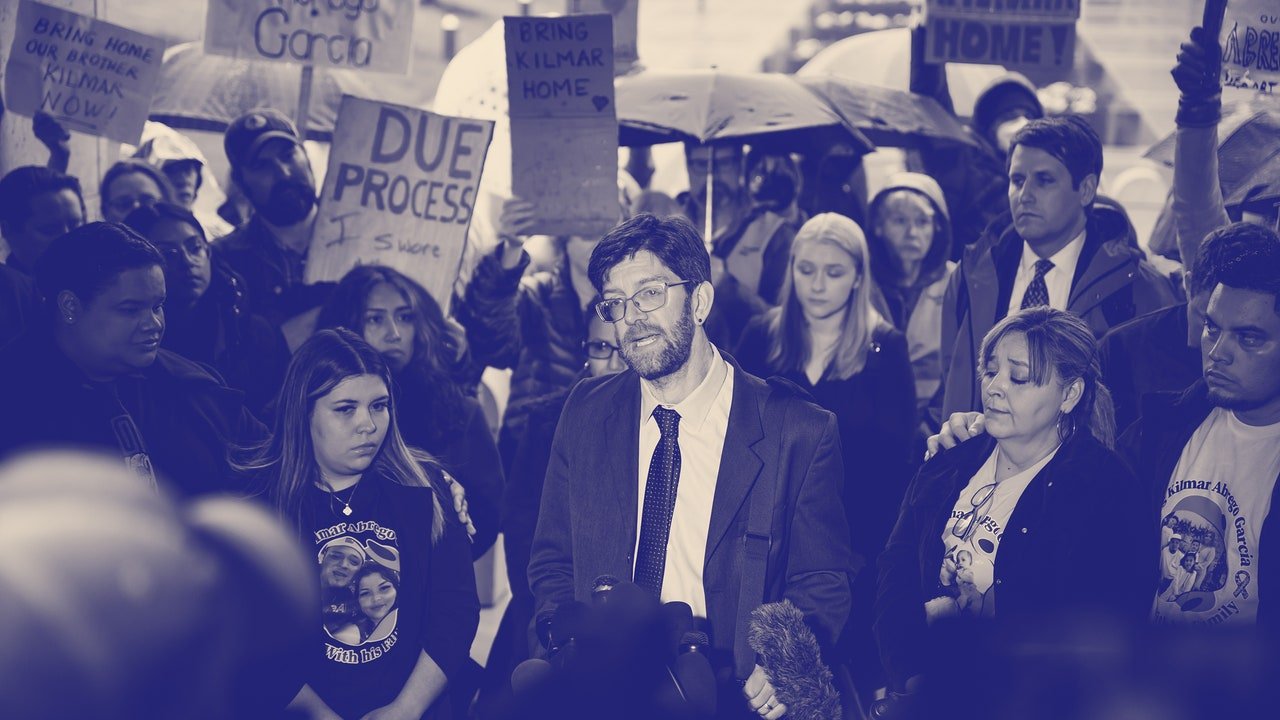
In March, the Trump Administration deported Kilmar Armando Abrego Garcia, a Salvadoran citizen who was living in Maryland with his family, to a notorious prison in El Salvador. After outrage grew over Abrego Garcia’s deportation, the Administration acknowledged that it was the result of an “administrative error.” A district court judge, Paula Xinis, ordered the government to “effectutate” Abrego Garcia’s return. Last week, the Supreme Court largely agreed with the decision, adding that “the intended scope of the term ‘effectuate’ in the District Court’s order is, however, unclear, and may exceed the District Court’s authority. The District Court should clarify its directive, with due regard for the deference owed to the Executive Branch in the conduct of foreign affairs.”
Meanwhile, the Administration has continued to ignore Xinis’s order, and has offered no explanation as to whether it has been doing anything to work toward bringing Abrego Garcia home. On Monday, Trump welcomed Salvadoran President Nayib Bukele to the Oval Office, where Bukele said that he had no intention of sending Abrego Garcia back to the United States. That same day, Trump’s advisor Stephen Miller contradicted the Administration’s previous, repeated statements that Abrego Garcia was sent to El Salvador by mistake, instead claiming that he was in fact supposed to be deported.
The Administration’s intransigence in the face of court orders, which has been a disturbing constant of the past several months, raises questions about whether the Supreme Court will put pressure on the Administration to follow the law. Last week, in a separate case, the Court ruled that the Administration could continue using a 1798 law, the Alien Enemies Act, to deport non-citizens, although those non-citizens have a right to due process to challenge their removals.
I recently spoke by phone about Donald Trump and the Supreme Court with Steve Vladeck, a professor of law at Georgetown, and the author of the Substack “One First.” During our conversation, which has been edited for length and clarity, we discussed how much the Supreme Court actually agrees with the Trump Administration on executive power, what happens now to the people sent to El Salvador, and why Chief Justice John Roberts may be putting off a confrontation that is inevitable.
You wrote recently, about the Supreme Court’s ruling in the Abrego Garcia case, “The deeper problem is that many (if not most) of us just don’t trust the Trump administration to behave on remand—which necessarily colors our view of the significance (and scope) of the wiggle room that last night’s ruling creates even as it unanimously rejected the broadest and most alarming claim put forth by the government.” Can you explain the ruling and what you mean here? Because it was one of those rulings where both sides claimed a certain amount of victory, right?
Yeah. So at the top level, at the highest level, I think it was a resounding loss for the Trump Administration, which had taken the position that federal courts were powerless in these circumstances—that once someone is in a Salvadoran prison, that’s it, and there’s nothing for the federal courts to do. It seems like a pretty important message for the Supreme Court to say that’s not true—that just because, you know, someone is in Salvadoran custody, at least physically, it doesn’t mean that the courts are powerless.
At the same time, as we saw in the hearing before Judge Xinis on Friday, the Court did not force the Trump Administration to do anything. And so it’s one thing to say, yes, federal courts have at least some power in these cases. It’s quite another to say that that includes the ability to demand that you return this person by this time, on this day. The Supreme Court didn’t do that.
But the Court did say, essentially, that the lower court could lay out steps to tell the Trump Administration what to do. You see a real difference between that and something much more direct?
I think it’s a bit broader. The Supreme Court did say that the federal court can order the Administration to “facilitate” Abrego Garcia’s return. But, in the same paragraph, it also said that the district court has to be sensitive to the deference that the executive branch is due in the context of foreign relations. And so if the Trump Administration shows up with a signed affidavit that says, We’ve washed our hands of this, we have no control, we have no ability to get him back, I don’t know that the Supreme Court’s decision gives the district court the power to disagree.
If the Administration does that, would the case just find itself back at the Supreme Court in a couple weeks?
I’m sure it would. There’s no question in my mind that this has become a test case both for the Administration and for the folks challenging the Administration. Because if the Administration really can evade judicial review, even functionally, if not formally, then what is to stop it from sending countless other people, citizens and non-citizens, to El Salvador under similar circumstances? And this is why I go back to how the Supreme Court’s intervention just hits differently because of who is currently in charge. We would not expect the Bush Administration or the Obama Administration or the Biden Administration to look at all of this like a Rube Goldberg device.
But did this decision seem to you like the conservative majority on the Court essentially trying to avoid a fight with Trump? Or is it that you think they have an idea of executive power that perhaps is different from yours or mine, especially when it comes to Republican Presidents, and that there may be some real agreement here? Because that’s different than wanting to avoid a fight.
I think it’s a mix of both, and I think it’s a mix of both in different proportions for different Justices. If you think about the six Republican appointees, I suspect that there are three or four for whom a lot of this is about executive power and not the Trump Administration. There are at least two, the Chief Justice and Justice Amy Coney Barrett, who I think are both less absolutist when it comes to executive power and more sensitive to the implications of judicial abdication at this moment.
But, going forward, you think that the Court needs to set some sort of red line?
I think a red line probably is the solution. And I think the problem is that the Court is very wary of drawing one. And it’s understandable, because you have a President who has been as critical of the courts as any we’ve seen in modern times, because you’ve had all of these attacks on lower-court judges and, frankly, because you have a Supreme Court that is less popular than it has been at any point in our lifetimes. Those things are all relevant.
The problem is that for all of the good arguments in support of this kind of temporizing by the Justices, we have an Administration that’s going to take any rope and run with it, that’s going to look at any temporizing and see a green light where others would have seen a yellow or a red light. I think the question for the Justices is, How much of that are they really willing to not just indulge but enable before they say, No further, no more? It seems like this is a powerful case for that, because it’s not just that you have Abrego Garcia sitting in this Salvadoran prison—it’s that you have the potential implications for so many others.
Source link






